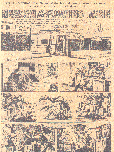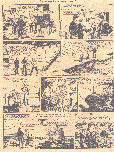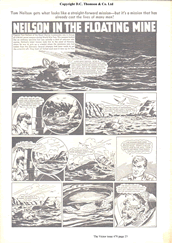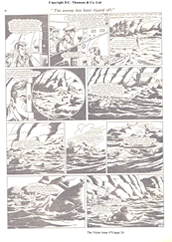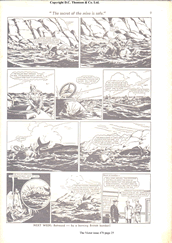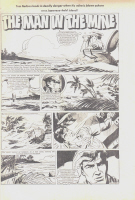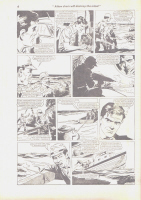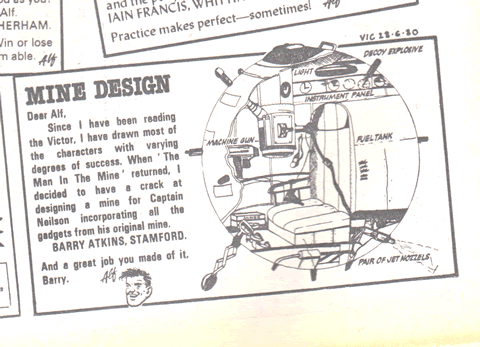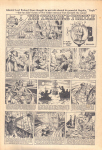First series - Neilson in the Floating Mine see The Victor Issues 465 to 478 (January 24th 1970 to April 18th 1970 ; Fourteen stories, 43 pages)
Reprinted between January and early April 1978 (issues 880 and 893)
Several appearances in the Victor Summer Special (1970; 3 pages) and annuals (1971; 8 pages).
Second series – entitled The Man in the Mine – Issues 991 - 1003. (16th February to 10th May 1980). Thirteen episodes.
Writers:-Not known. Artists:- first series Diaz?; second series - not known.
Main cast:- Captain Tom Neilson and not forgetting his amazing mine.
Time period:-Second World War (Europe and the Far East).
One of the more popular strips to appear in The Victor, the mine is better remembered than its commander,
Captain Tom Neilson, a tough, resourceful and courageous Royal Marine commando. And it’s a great idea, the mine on
outward appearances looks just like a real, live mine. And it was the mine’s outward appearance which gave Neilson
the perfect cover. Who in their right mind wants to get too close to a mine’s explosive horns? But in fact it is a one
man submarine, equipped with all sorts of gadgets, such as a machine gun, harpoon style missiles and extendable steel
grippers and cutters. These all operated through the mine’s horns. The mine could also simulate an explosion described in
the comic as the thunderflash device. And like a submarine the mine had a periscope, could submerge or float and
(according to its inventor Dr. Potter), could be propelled along by its jet engine!
A young boy might have queried how Neilson was able to change inside the submerged mine into full diving gear,
(complete with an oxygen tank), in such a confined and cramped space or how he could exit the submerged mine without
flooding it. And how it could on occasions carry two people. And how exactly did that periscope work? If the young reader
did think about these things they probably flitted across his mind briefly, before moving onto reading the exciting stories.
The first series saw Neilson involved in fighting the Germans in the seas around Europe.
No task whether it was big or small was too difficult for Neilson and his mine to tackle. The Royal Marine
successfully sank the German battleship Siegfried, retrieved diamonds from smugglers, foiled a spy’s attempts at sabotage,
and blew up a big gun mounted on a railway flat top wagon. Neilson’s last mission in the first series, saw him
tackling an enemy midget submarine. The enemy submarine exploded, badly damaging the mine and wounding Neilson.
The strip must have been popular as it appeared in the 1970 Summer Special and 1971 annual and possibly other specials and
annuals. Both of these stories took Neilson and his mine to the Pacific Ocean on further perilous missions.
The unknown artist for this strip did a fantastic job in producing very detailed and crisp artwork of figures and naval
craft. The artist makes good use of liberal amounts of black ink. And he’s in good company, as Will Eisner, the
creator of The Spirit, used heavy ink shading to provide mood and atmosphere for his darker Spirit stories. Eisner
refers to these stories as a ‘two bottles of ink story.’ (The Spirit, p.1, Kitchen Sink Comics, 1986). However, these two
strips are worlds apart. Eisner was working under great pressure, producing a seven page script per week, week in, week out.
Whilst also at the sametime inventing new ways of telling a story in a graphic comic strip. This certainly wasn’t happening
in the Floating Mine series. Maybe the artist by using liberal amounts of ink was trying to show that Neilson operated
in a small, confined space or if the use of black ink was just his style.
The scripts did let the series down by relying on the same type of plot that is, ‘the something needs to be blown up’
storyline. Several stories though are of interest, notably the use of the ‘unexpected element plotline’ in several stories.
And it is one of these stories that you can read for yourself below.
The idea of a miniature submarine being used isn’t all that unusual and The Victor proved that by publishing a one
page article about the history of submarines. It’s surprising that submarines have been around since the American Civil
War.
Ten years after the first series appeared, the second series was published in 1980. This series was entitled The
Man in the Mine, and saw Neilson and the submarine mine fighting the Japanese in the Pacific Ocean. The missions
were similar to the first series operations, but did provide Neilson with further new challenges. For example the
investigating of ghostly apparitions, a reconnaissance mission of an island and helping out the Yanks. Who always
managed to get themselves entangled in some situation they couldn't get out of. Needing a helping hand
from our brave British and Commonwealth lads to get them out of whatever trouble they had got themselves into.
The artist for the second strip was different and as you would expect the artwork was different. I found the artwork
‘less crisp’ and detailed compared to the artwork of the first strip, but not unenjoyable. It’s difficult to tell if the
strip had a new writer or not, but with a ten year gap between series, it’s probably likely. The new writer probably had
to write the new episodes in the style of the first series. That, as far as I am aware was the last series of Captain
Neilson and the mine.
Please click on the images below to view a complete episode of Neilson in the Floating Mine, from the first
episode. Use the back button to return to this page, then select the next page of the story.
All images below are copyright D.C. Thomson & Co., Ltd.
The below story is the first episode of this series and was published in the Victor issue 465.
The story below is from the second series, issue 995.
The cutaway image of Neilson's mine on the left below, was drawn by a reader of The Victor and appeared in
The Victor's letters page issue
1010. Click on the image on the right below to read a factual account from issue 478 about the world's first
submarine, The Turtle. Artist Bevan. Was it The Turtle that was the inspiration for this series?
 |
 |
© Adrian Banfield, 2008.


